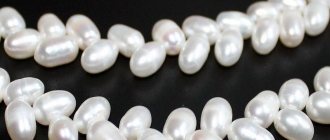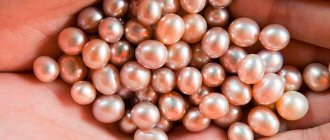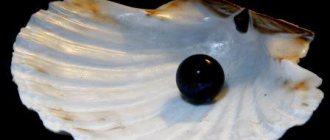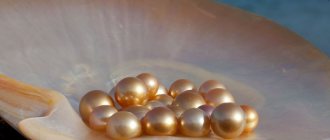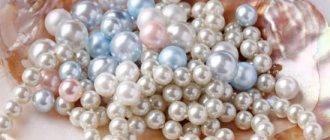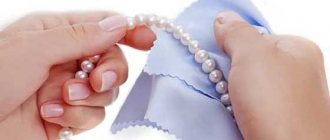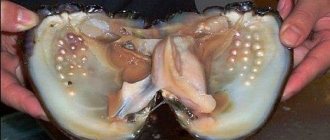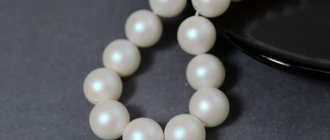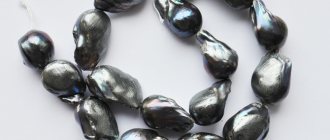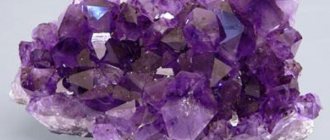Quote from _Sofia-9_
Read in full In your quotation book or community!
Abalone pearls are one of the rare and expensive types of pearls known to people.
The mollusk in which this amazing jewel grows is a valuable commercial species. Its meat is considered an expensive delicacy in many East Asian countries - Japan, China, Korea and Vietnam, as well as in Latin America, New Zealand and France.
Due to illegal fishing off the coast of South Africa, the population of Abalone shellfish, or abalone as they are also called, was practically destroyed. As a gastronomic delight, they are grown on farms in many countries.
Birth of a pearl
The Abalone mollusk is a fairly common species. Its single-leaf shell, completely inconspicuous on the outside, has an amazingly beautiful inner layer - mother-of-pearl, bright, shimmering with many colors and shades. The shell itself is also used in jewelry making and inlay work.
The high cost of Abalone pearls is due to the fact that mollusks rarely produce pearls. This process begins only when a fragment of its own shell gets inside the mollusk. The chance of finding Abalon pearls is 1:50,000.
By covering this fragment with mother-of-pearl, layer by layer, a pearl is formed, the same color as the shell. The most valuable are purple, pink, as well as green and bright blue iridescent colors.
Main characteristics
Heliots is a stone that consists of protein molecules and most of calcium carbonate, so it is very strong, but also quite fragile. Despite its strong structure, Abalon is recommended to be protected from close contact with fire and high temperatures. This is due to the fact that pearls contain a large percentage of water; when it evaporates, it exposes the stone to damage, such as cracks. You should also avoid contact of this type of pearl with cosmetics. Since the presence of various kinds of acids in their composition can also lead to its destruction or loss of luster of mother-of-pearl. In order to clean this mineral, you can use regular potato starch.
Due to the fact that this mollusk is a single valve, its pearl shapes are always interesting. There are practically no stones that are alike in nature. This also applies to the color of the pearl itself. Due to its uniqueness, this stone is quite expensive. In addition, its cost is also influenced by the fact that this type of abalone very rarely produces pearls. Therefore, jewelers use the shells themselves as decoration, which, due to their incredible colors, are very popular among the fair sex.
Standards
The Abalone mollusk is capable of growing unusually large pearls. The pearl can grow by attaching itself to the wall of the shell and will eventually take the shape of a hemisphere. Jewelers use such stones together with the part to which they have grown. Those pearls that grow freely have bizarre, amazing and completely unique shapes. In nature, there is not a single Abalone pearl of ideal shape and with an absolutely smooth surface.
Variety of abalone shell colors.
Amazing pearl colors. Abalone pearl can have any shades of color: purple, blue, gray, green, silver, violet, cream. The most valuable are bright blue, green or purple colors.
The closest stones to the correct shape are small ones, weighing 5-10 carats.
Small dark “seams” in the form of thin stripes or spots are considered a characteristic feature of this type of stone. A pearl with a minimum number of such “seams” and the most correct shape reaches a cost of 3,000-6,000 thousand dollars per 1 carat.
The main criterion when assessing the cost of a stone is the whimsicality and uniqueness of its color and unusual shape.
Famous jewelry designers create their unique masterpieces partly thanks to these “imperfections.” To play around and harmoniously combine such a pearl with other stones and metals, you need to have talent, taste and unsurpassed skill. Owners of such products can be sure of their complete exclusivity and uniqueness.
The mollusk is a single-valve shell in the form of an “ear”; it is on it, on the inside, that a pearl can begin to grow.
An Abalone pearl, carefully nurtured by a single-vave mollusk.
The mollusk lives for about 10 years, but under favorable conditions, some species can live up to 40 years.
It is extremely difficult to cultivate such pearls. The main places where this mollusk lives are the coastal areas of the Pacific Ocean off North America, areas of New Zealand, Korea, and Japan.
Pearl of Abalone
Abalone is a mollusk that produces one of the most amazing and unusual types of natural pearls and is also a delicious seafood delicacy.
Significant collection of Abalone shellfish occurs in Japan, Korea, Australia and New Zealand. The collection is carried out by divers, often in extremely difficult natural conditions and involves a great risk to life.
The average lifespan of a mollusk is about 10 years, but under ideal conditions this mollusk can live up to 40 years.
Abalon's shell is shaped like an ear
Bright “gasoline” tints and a unique graphic texture distinguish the Abalone shell from any other mollusks. There is a whole industry for the production of mosaics, caskets, interior items, accessories, costume jewelry and simply various carved items from these shells.
Unfortunately, the value of Abalone as a gastronomic delight has led to catastrophic declines in shellfish populations, for example, off the coast of California.
Abalone is capable of creating pearls of enormous size, amazing shape and unique beauty. Abalone comes in the form of a blister (hemisphere) and a whole pearl, not attached to the shell.
Unlike natural Conch and Melo pearls, Abalone pearls have a mother-of-pearl layer and come in a wide range of shades. Pink, green and blue are the most rare and valuable.
Abalone pearls are characterized by black “seams” that range from fine dark lines to large spots.
Pearls with symmetrical shapes and few or no dark spots are very rare and command a high price of $3,000-$6,000 per carat.
As a rule, symmetry is typical for small pearls weighing 5 - 10 carats.
Large pearls weighing more than 15 carats usually have an elongated, bizarre shape with pronounced black “seams”, spots and chips of the nacre.
Since Abalone with an ideal surface is incredibly rare in nature, “seams” and stains are perceived by market experts as an integral part of its nature. And when estimating the cost of pearls, greater emphasis is placed on the pattern of play of colors and the whimsicality of shapes.
This greatly complicates the work of jewelry designers and craftsmen, because in order to play with the natural shape of Abalon, hiding the flaws of its surface and emphasizing all its beauty, they have to create original and very effective jewelry.
Owners of such jewelry know for sure that there is no second such product and it is no longer possible to repeat it.
signature
In the 1980s, a diver found a green, clear, wedge-shaped Abalone pearl weighing 118.57 carats off the coast of California. Its retail price at that time was more than 140,000 US dollars. Since then, the natural pearl market has shown an increase in demand for this rare type of pearl among collectors from all over the world, which also leads to an increase in value.
The House of Pearls of Xenia Celestial Empire cooperates with the largest dealers of Abalone pearls in Japan and Australia, which allows us to fulfill any orders from the most sophisticated collectors.
AWABI (awab - Japanese) or Abalone (abalone, from Spanish abulon). abalone shellfish
AWABI/Abalon
Abalones meat is considered a delicacy in modern cooking and is consumed both raw and cooked in various dishes. Abalone is used for food, and shellfish shells are used as decorative items, and as a source of mother of pearl for jewelry and other decorative items.
Abalone has long been a valuable source of food for people in every area of the world where this shellfish exists in abundance.
The meat of this mollusk is considered a delicacy in some countries of Latin America (especially Chile), France, New Zealand, Southeast Asia, and East Asia (especially China, Japan and Korea). Dishes made from awabi are slightly similar in taste to shark fin soup or bird's nest soup. Such dishes are considered a luxury item and are served on special occasions, such as weddings and other celebrations. However, the presence of commercial abalone farms has increased the overall consumption of this rare delicacy.
In California, farmed shellfish meat can be found on pizza or in steak.
In Japan, raw abalone is used in awabi sushi , or served stewed, salted, boiled, sliced, or boiled in soy sauce.
In Japan, Abalone is called Awabi . The same marine mollusk, known in America and Europe, but also found in the waters of Japan. Awabi is a symbol for the people of Japan. During a meal, awabi is always present in one dish or another on the Japanese tables - thereby they pay tribute to their poor ancestors, for whom awabi was sometimes almost the only dish. The Japanese also have a custom of putting a small piece of the meat of this mollusk in each gift “for good luck.”
Avabi (awab) . 1. Abalone (Japanese cuisine). 2. The Japanese name for pearls found in the shells of abalones - abalones of the genus Haliotis. Their coloration is distinguished by a rich range of colors and a predominance of dark tones.
AWABI (Abalon) is an edible univalve mollusk (genus Haliotis), the shell of which is shaped like a human ear.
In addition to the Japanese word Awabi, there is also Abalone (abalone, from Spanish abulon). Both words have the same meaning - the shell of marine mollusks of the genus Haliotis (abalone). Abalone is also called pearls and mother-of-pearl of chaliotis, which is distinguished by its unusual strength and richness of shades of color. The connection between calcium carbonate platelets and protein molecules in abalone is not rigid; individual plates may move slightly relative to each other. As a result, nacre with such a structure is able to absorb shock in response to mechanical shocks. This is precisely the secret of the extraordinary strength of abalone.
The clam meat is tender, snow-white on the outside and yellow on the inside. It is considered a seafood delicacy.
Magic properties
Since the stone has been known since very ancient times, people have become convinced of its extraordinary abilities, which help improve the general condition of the human body. For example, talismans made from Abalon stone protect family life, allowing you to find harmony and comfort. Therefore, in ancient times, many household items were made from them and given as wedding gifts to newlyweds. In addition, wearing jewelry made from these pearls has a beneficial effect on people who are directly related to social activities. There is a belief that, thanks to its properties, the stone is able to inspire trust in others.
As for astrology, Abalon has a positive effect on all signs of the Zodiac, but has a particularly beneficial effect on Pisces, Cancer, Libra. Due to its incredible beauty and uniqueness, this type of pearl, despite its high cost, is very popular among women all over the world.
Must read: no similar posts
